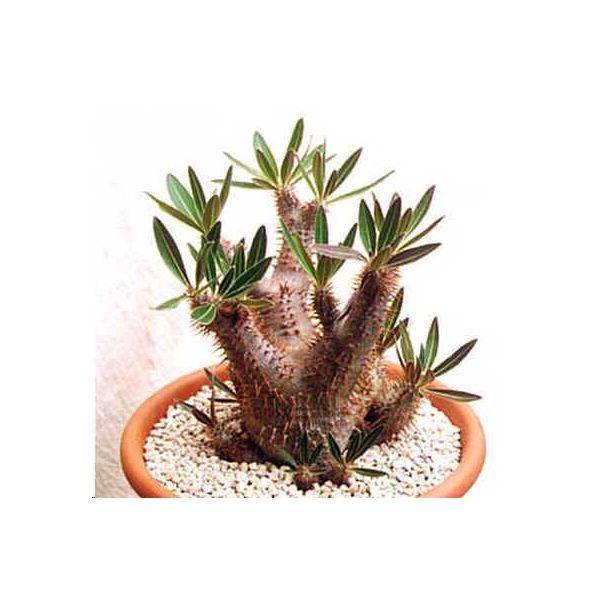Pachypodium Densiflorum Seeds
Pachypodium Densiflorum Seeds
Over time you can develop a truly stunning specimen! This plant can also be grown as a Bonsai!

Delivery
All orders shipped with UPS Express.
Always free shipping for orders over US $250.
All orders are shipped with a UPS tracking number.
Returns
Items returned within 14 days of their original shipment date in same as new condition will be eligible for a full refund or store credit.
Refunds will be charged back to the original form of payment used for purchase.
Customer is responsible for shipping charges when making returns and shipping/handling fees of original purchase is non-refundable.
All sale items are final purchases.
Help
Give us a shout if you have any other questions and/or concerns.
Email: contact@domain.com
Phone: +1 (23) 456 789
Availability: In stock
SKU
Pachypodium Densiflorum
Pachypodium Densiflorum belongs to the Apocynaceae family. This species occurs in central Madagascar. This is one of the very top species for cultivation. The bright silver caudiciform body and small contrasting blunt leaves makes it one of the most attractive in the entire genus. It's a moderate grower and an impressive caudex can be steadily developed. And let's not forget the attractive chrome yellow flowers. Its name means literally ?dense flowered? which is an apt description of its abundant floral display. Over time you can develop a truly stunning specimen! This plant can also be grown as a Bonsai!
This is a wonderfully fat, multi-branched plant. The smooth trunk is silver with a light green tint. With great age it may develop a swollen stem that can attain a diameter of up to 6 feet (2 m) in width and a height of about 2 feet (0.7 m) with numerous short, thick, erect tapered branches. The branches are covered with conical spines. They are thick, short and silvery. The deciduous soft leaves are elliptic, dark green above and paler below. The paddle-shaped leaves have a lighter middle vein and symmetrical venation.
This specie can flower at a very young age even if it usually takes 2 years. The flower grows on very tall stalks, far above the plant. They are deep yellow, sometimes tinted deep yellow and orange and appear in springtime. The flowers have a corolla that opens nearly flat, having a saucer-like depression with the center exposing 5 antlers, the center of which is set on long peduncles with several flowers.
Pachypodium is a plant genus that belongs to the family, Apocynaceae . Pachypodium comes from Greek pachy (thick) and podium (foot), hence meaning thick-footed. This Pachypodium will not require any pruning to look like a very interesting and unusual bonsai. This plant is a succulent and will not require lots of attention and is very forgiving should you forget to water it.
Hardiness zones: 10 ? 11 (1c/35f, 4c/40f). The Pachypodium Densiflorum plant should be given full light and plenty of water during the warmer months and considerably less water in the cool months. Do not let this specimen sit damp in cool weather. It is definitely tender and should not be exposed to frost. This plant will grow well in any well drained soil mix. Cold sensitive it is not a good outdoor plant in some zones, but a great pot specimen. This plant has spines or sharp edges; use extreme caution when handling. They are drought-tolerant, suitable for xeriscaping. The plants grow in southern, central and northern Madagascar on granite outcrops at altitudes of about 1 500 m.
Two significant adaptations allow Pachypodium to survive in dry, hostile environments: ?pachycaul? trunks, and spines. The thick, more or less pithy, trunks of Pachypodium facilitate water storage similar to a cactus. The trunks and branches can also photosynthesize, making the leaves, which can cause rapid water evaporation from the plant, unnecessary in times of drought. Spines help condense moisture from fog or dew into drops which fall at the base of the plant.
.
| Label | Pachypodium densiflorum |
|---|---|
| Genus | Pachypodium |
| Species | Pachypodium densiflorum |
| Germination | The Pachypodium Densiflorum seedlings grow fairly easily. Sow the seeds in a 5 mm deep, sterile, sandy medium (4 parts fine and 4 parts coarse river sand; 1 part sieved, well-rotten compost; 1 part perlite; 1 part vermiculite) in summer. Keep the mix moist and at a temperature of 27?35øC to ensure rapid germination. Transplant the growths in small pot to support compactness rather than the growth which produces untidy plants. Germination can take longer. Be patient! |
| Price View | Price Range |

